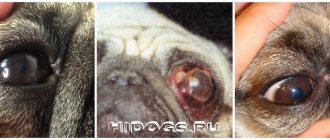Causes of redness
At risk are breeds with long floppy ears (dachshund, poodle, spaniel, basset hound, some terriers and more). But from time to time other dogs also suffer from ear sores accompanied by redness of the ear.
Redness is often accompanied by itching, pain and accumulation of fluid with an unpleasant odor . The animal shakes its head, scratches its ears until they bleed, loses its appetite, sleeps poorly (wanders from place to place). Sometimes your pet's temperature rises. The doctor will tell you what exactly caused the redness of the inner surface of the ear, and the owner’s task is not to delay visiting the veterinary center.
Allergy
Any substance (more often a food ingredient) can act as a provocateur; after it enters the body, the ear turns red, the skin flakes and becomes covered with pimples, and severe itching begins. In severe cases, purulent yellowish-gray discharge appears.
Important! The culprits of allergic otitis are both atopy (hypersensitivity to environmental components) and food allergies, which are common in dogs.
Food irritants are often fish, yeast, chicken, rice, wheat and oats, but it is possible that your dog will react negatively to some other foods.
Infection and parasites
Unnoticed allergic otitis media is often complicated by a secondary infection (fungal or bacterial) . In this case, the epidermis of the external auditory canal not only turns red, but also thickens (in chronic forms of the disease), and a high concentration of sulfur is observed. If neglected and complicated by infection, otitis media can lead to complete loss of hearing; moreover, a chronic disease is less easily treated and causes noticeable discomfort to the dog.
Ear itching and redness are also characteristic of parasitic diseases, such as:
- demodicosis;
- otodectosis;
- cheyletiellosis.
In addition, with a parasitic infection of the ear, moist or dry dark brown discharge is formed in it.
Foreign body
As a rule, it gets into the ear canal of dogs (especially hunting ones), which often walk in forested areas. A limited area of redness will indicate that a foreign body, for example, a seed or a blade of grass, has entered the ear. In this case, you can do it yourself - remove the irritant from the dog's ear.
Other aspects
Ear injury
Dogs with large ears sometimes injure them during active play, resulting in bruises. With a hematoma, the ear not only turns red, but also becomes noticeably hot, which indicates a ruptured blood vessel.
With this damage, blood often accumulates between the skin and cartilage, which leads to severe swelling of the auricle.
Poor ventilation
A wide ear blocks the passage of air, causing moisture to accumulate in the inner ear canals, which allows pathogenic bacteria to multiply easily. The solution is early ear cropping . This operation is necessary not so much for the pet’s appearance as for its health.
Vestibular disease (peripheral)
Redness can be a sign of damage to the middle or inner ear, in which the dog loses balance and orientation. This means that the vestibular apparatus of the animal is affected.
Symptoms to watch out for:
- the head is unnaturally tilted to one side;
- the ear turns red and hurts;
- the dog spins/falls towards the head tilt;
- nausea and vomiting;
- It hurts the dog to open its mouth and chew;
- loss of appetite.
Bathing
Ears often turn red after an unsuccessful bath, when water gets into the ear canal and causes inflammation. When washing in the bathroom, always plug your pet's ears with cotton balls, and when outdoors, remove moisture with a swab.
Also, the inner surface of the ear may change color to red after a tick bite.
Return to content
Reasons why a dog shakes its head and ears
If your pet behaves restlessly and often shakes its head and ears, then a possible reason for this behavior lies in:
From the above examples it is clear that redness, squelching and head shaking are symptoms that occur with similar diseases and problems.
Let's take a closer look at the excellent reasons:
Injury
When a pet is injured in the head, vomiting is observed due to the resulting concussion. The movement of the head is due to an attempt to regain consciousness and maintain balance.
Neoplasms
Even harmless papillomas can become a serious problem if they accumulate excessively and cause blockage of the ear canal.
Helminthiasis
Blood-sucking insects
Lice and fleas that feed on the owner's blood cause severe itching, so the pet literally tries to shake them off the head.
Chlamydia
Bacterial damage can be recognized by tearing and sneezing. Try using acaricidal drugs and if there is no response, be sure to consult a doctor.
Under certain conditions, even ordinary water is fraught with disastrous consequences. For example, salt water causes burns, and water from a stagnant body of water is teeming with bacteria.
Close-up view of middle ear inflammation in a dog
First aid for redness
If a tick is found, it is removed independently or in a clinic . This is not a very complicated procedure, especially since tools for effectively capturing attached parasites have appeared on the market.
Important! If a foreign body is lodged in the ear canal that you are unable to remove (due to the depth of penetration), do not risk it - take the dog to the hospital. Inept actions will only aggravate the situation - you will only push the foreign object even further.
To stop allergic manifestations, give your pet (based on its weight and age) any antihistamine. This will relieve ear redness and itching, but will not get rid of allergies. If you don’t want to test your animal for allergens, try to find the irritant yourself.
There is a special technique for this, with a step-by-step elimination of foods/types of food: it will take more than one day or even a week, but you will understand what food causes an allergic response.
If you focus on industrial food, try switching the animal to a new, dietary line of products or switching to a natural menu. In the latter case, the products are not mixed, but introduced gradually, observing the dog’s reaction.
If you were unable to detect the allergen, and your pet’s ears are still red and itchy, you will have to visit Aibolit.
Return to content
Possible diseases and their treatment
The main task of a dog owner is to monitor the health of his ward. It is important to regularly inspect your dog’s ears, noting the slightest changes. In normal condition, the skin of the ear on the inside should have a pale pink tint and be free of foreign odors. Why your dog has red ears – a veterinarian should help you figure it out.
There are a number of reasons that provoke the development of redness in a dog’s ears. The main ones are:
- Insufficient ventilation
. Occurs in many dogs, but mainly affects breeds with long and floppy ears. Most of the auricle closes the external auditory canal, preventing microcirculation of air masses penetrating into the area of the inner ear. Accumulated excess moisture is an excellent breeding ground for pathogenic microorganisms. During an inflammatory process caused by bacteria, the dog develops discharge from the ear, accompanied by an unpleasant odor. It is possible and necessary to prevent inflammation in such pets by carrying out timely hygienic treatment of the auricle. Excess hair should be cut off, and the ear canal should be treated with special products to remove excess moisture and dirt. - Allergic reactions. As a result of allergic reactions, not only internal organs suffer, but also external ones. Redness on the ears as a result of allergies to food with individual intolerance to certain foods is a fairly common occurrence, especially among small breeds of dogs. Products that provoke the onset of allergies can be wheat, rice or poultry, as well as granulated dry food. If a veterinarian suspects the onset of an allergy, the pet is prescribed treatment, which includes the exclusion of foods that cause a reaction, as well as the use of special antihistamines (the dosage and course of treatment must be prescribed by a qualified doctor).
- Foreign objects in the ears
. If various insects, plants or other objects enter the external auditory canal and are exposed for a long time, the animal may experience irritation and redness in the ears. It is necessary to conduct a thorough and, most importantly, regular examination of the pet’s hearing organs after each walk in nature. It is not recommended to remove a foreign body yourself, since any careless movement can lead to more serious consequences (pushing the object into the deeper layers, where it will be much more difficult to get it out). It is advisable to contact a veterinarian who can properly restrain the animal and remove the object causing inflammation. - Redness after water treatments
. Quite often, dog owners pay attention to the fact that after bathing, the dog’s ears turn red on the inside. Water that gets inside the ear may not come out on its own, even if the pet actively shakes them. As a result of this, an inflammatory process occurs, which is treated by a veterinarian. Cotton pads inserted into the dog's ears before bathing will help prevent the situation. After the procedures, cotton swabs must be removed. - Otodectosis. An ear infection in dogs and cats caused by ear mites. The disease can be transmitted from sick animals to healthy ones through contact. In addition to hyperemia as a result of inflammation, otodectosis is always accompanied by other characteristic symptoms - severe itching and an unpleasant odor from the ear canal area. The pet can tilt its head in one direction or the other. An accurate diagnosis can only be made in a veterinary hospital, since the diagnosis includes a scraping to determine the pathogen. Ear mites are a fairly dangerous disease, treatment of which lasts several weeks in mild forms. In advanced cases, treatment is more expensive and longer. If you do not consult a doctor in a timely manner, otodectosis can lead to serious consequences and even complete loss of the dog’s hearing.
- Otitis. Inflammation that occurs inside the ear affects many pets. Otitis can occur as a result of various reasons - with a decrease in immune defense, allergic reactions, colds, proliferation of bacterial pathogenic microflora or fungi. It is extremely difficult not to notice the manifestations of otitis, because in addition to the fact that the dog has hot ears, a number of characteristic signs also arise, such as constant itching and discomfort (the animal constantly scratches its ears), refusal to eat, increased body temperature, lethargy and apathy, unpleasant odor from the ear canal. With fungal otitis, an unpleasant, sweetish odor is heard from the ear, and with bacterial purulent otitis, a specific exudate is released from the ear canal.
Diagnosis of redness of the auricle is carried out in a complex manner and includes several stages. When contacting a doctor, the specialist must collect anamnesis and conduct a clinical examination of the animal, during which the affected part of the outer and middle ear is examined.
When examining, it is important to focus on the condition of the eardrum, the skin inside and the presence of edema. Otoscopy (examination of the auricle) includes registration of possible discharge from the ear canal area, skin hyperemia, pain during palpation, and bulging of the eardrum.
If a certain pathology is suspected, specific laboratory tests are prescribed. The main ones are:
- general blood analysis;
- cytology of secretions (carried out to determine pathogenic microflora, diagnose possible tumor processes, autoimmune diseases, hyperplasia of sulfur-producing glands);
- scrapings and further examination under a microscope (carried out to identify ear mites and pathogenic bacterial microflora).
Rarely, but in the absence of a reliable picture of the pathological process, a veterinary specialist may prescribe an x-ray examination to identify a neoplasm or polyps in the nasopharynx that provokes the development of otitis media.
An attentive dog owner always conducts regular examination of the ears, which allows timely detection of the onset of pathological processes. Do not worry if your pet secretes a small amount of a brown substance that does not have a strong unpleasant odor. This is earwax, which is necessary for the normal functioning of the hearing aid. Regular ear cleaning using special lotions will help prevent serious diseases associated with your dog's ears.
Long-eared and long-haired dog breeds require regular plucking or trimming of the hair in the ear canal. This will improve air microcirculation, preventing moisture from retaining and causing inflammation.
After long walks in nature, among tall grass or in the forest, it is necessary to inspect the dog’s ears for foreign bodies. An important role in the prevention of otitis media and other pathological conditions of the auricle is played by the general strengthening of the immune system.
Redness of the inner surface of a dog's ear is a fairly common occurrence. This organ is constantly exposed to the external environment: temperature changes, wind, and the danger of sunburn. The ear is a kind of indicator of the dog’s general physical condition (it signals the owner about an increase in body temperature, the body’s reactions to certain types of foods). The location of the ears makes them vulnerable to mechanical damage.
Long-eared breeds suffer from insufficient ventilation. The long outer part of the ear, covered with hair, interferes with the natural cleansing of the ear canal, as well as the evaporation of moisture and sweat accumulated there, which creates a favorable environment for the proliferation of various microorganisms and, as a result, the development of inflammatory processes.
If the inside of the ear turns red in a dog with naturally small or cropped ears, then the cause is most likely an insect bite or an allergic reaction to something.
It’s not difficult to guess that your pet has ear problems by looking at his behavior. The dog twitches its ears, tilts its head towards the sore ear and shakes it, rubs against pieces of furniture, carpet, grass in the yard with the side of its head in which it feels discomfort.
Press lightly with your fingers on the base of the entrance to the ear canal from the side of the muzzle. If an animal feels pain, then the pathological process is happening internally, and it cannot be done without the help of a specialist. In other cases, you can deal with the problem yourself.
The table shows the main causes of red ears in dogs and recommendations on how to get rid of it.
| № | Cause | How it manifests itself | How can I help you |
| 1. | Allergy | 1. A small, pale pink rash appears on the inner surface of the ear; pink spots of irregular shape; 2. severe itching, peeling. | 1. Identify and eliminate the allergen. 2. Try to relieve (or at least reduce the itching). To do this: treat the ear on both sides with a weak aqueous solution of vinegar; Apply anti-allergy ointment (veterinary!). 3. If the allergen comes from food, use sorbents (Enterosgel, Tzamax or activated carbon) and a mild laxative for rapid removal. 4. Give your dog an antihistamine (after consulting your veterinarian). 5. Monitor your diet more carefully. |
| 2. | Increased body temperature | Red, hot ears indicate overheating or a high temperature in a dog. | 1. If the animal is overheated, place it in a cool place, give it water at room temperature, and limit activity. 2. It is necessary to bring down the temperature during illness simultaneously with the treatment of the pathological process. Consultation with a specialist is advisable. |
| 3. | Foreign body entering the ear canal | 1. Hearing loss; 2. anxiety; 3. The dog constantly rubs his ear with his paw. | 1. Carefully examine the sore ear. 2. If the object is shallow and it is convenient to pick it up with tweezers, calm your pet and do this. 3. In the case where the body has penetrated deep into the ear canal or has a rounded smooth surface, do not take risks. Contact a specialized clinic for help. |
| 4. | Poor ventilation | The inside of the ear is inflamed and bright pink or red; in advanced cases, a whitish coating and an unpleasant odor may appear. | 1. Wash the affected surface with a decoction of chamomile or calendula; treat with hydrogen peroxide. 2. Using cotton swabs, clean the ear canal (you can drop a few drops of hydrogen peroxide into it). 3. Lift the animal’s long ears and secure them above the head with an adhesive plaster. Let it be like this while it heals. 4. Treat inflamed areas with an alcohol solution of chlorophyllipt, and wet areas after treatment with a thin layer of talc. |
| 5. | Insect bites (mosquitoes, horseflies, ticks, fleas, flies, etc.) | 1. Red spots with a dark dot in the middle. 2. Swelling. 3. Soreness or itching. | 1. Immediately after the bite, wipe the area with a weak water solution of vinegar. 2. If the animal is injured away from home, you can use unsweetened grape juice or at least a piece of tomato. Anything that has a mild sour taste will do. This neutralizes poisons and relieves swelling. Usually these actions are enough. 3. If the redness does not go away, use any allergy remedy. |
| 6. | Fungal or bacterial infection, ear mites | The inside of the dog's ears are bright red; there may be hearing loss. | 1. Contact the clinic to identify the causative agent of the process. |
| 7 | Mechanical damage | These can be lacerations, bites, punctures, burns, etc. | 1. For minor damage, treat the wounds with hydrogen peroxide and lubricate with brilliant green. 2. Use anti-burn sprays to treat burns. 3. For extensive wounds, immediately seek help from a veterinarian. |
Treatment of otitis media
Inflammation of the outer ear is often diagnosed in dogs, especially since due to the sluggishness of owners, the disease takes a chronic form. The cause of otitis media is not so easy to determine: to do this, you need to examine the discharge from the external auditory canal.
Having found out the nature of the disease (fungal or bacterial), the doctor will select effective targeted medications. To make diagnosis easier, do not apply topical ointments, lotions, or gels that relieve symptoms before visiting a doctor.
When treating otitis media, various methods are usually used, including:
- ear nerve block;
- rinsing the ear canals with sodium bicarbonate solution, then tannin with glycerin (1/20), zinc sulfate solution (2%), creolin (1/200), ethacridine lactate (1/500) and streptocidal powder;
- treatment with a solution (2%) of silver nitrate, iodine glycerin, boric alcohol or hydrogen peroxide;
- menthol on vaseline oil 1–5% concentration (for severe itching).
This is interesting! Since these methods did not always give the desired effect, they tried to treat inflammation of the outer ear with chymopsin, used for chronic purulent otitis.
- The auricle along with the external auditory canal is wiped with a 3% solution of hydrogen peroxide.
- The treated surfaces are dried with a cotton swab.
- A few drops of chymopsin solution (0.5%) diluted in physiological sodium chloride solution are injected into the ear.
The regimen is repeated two to three times a day until the dog’s final recovery.
Return to content
Pug ear allergies
Otitis media in dogs can be caused by various factors. It happens when ear inflammation was caused by an allergic reaction - this condition of the pet is called allergic otitis. The disease develops according to the same principle as other types of allergies in animals, only in this case the pug's weakest point - the ears - is affected.
Read Causes and treatment of persistent hiccups in adult dogs and puppies
Severe itching is provoked by the fact that the pug begins to scratch the ear, open wounds appear, and other bacteria get there, which provoke inflammation of a non-allergic etiology. To avoid undesirable consequences, you need to quickly recognize allergies in your pug’s ears. Veterinarians identify the following main signs of allergic otitis media in dogs:
- Itching, redness and dryness in the ear;
- Swelling of the ear;
- Serous discharge from the ears;
- Frequent shaking of the pug's head;
- Severe pain, the dog does not even allow you to examine the ear;
Most likely the animal has an elevated temperature. It is almost impossible for the owner to distinguish otitis of allergic etiology from other types on his own; to do this, he needs to undergo diagnostics. I wrote more about allergic otitis media here.
Precautions, prevention
To prevent parasitic otitis, apply the insecticidal agents Frontline, Stronghold and others to the withers of animals monthly. After returning from a walk, do not forget to carefully examine the dog, paying special attention to its ears.
Periodically wipe the inner surfaces of the ears: you can use wet baby wipes, as well as special ear lotions . Cotton drops or medicinal preparations are prohibited unless prescribed by a doctor.
For long, adjacent ears (if they have not been cropped in a timely manner), daily combing of long hair from the back/front side of the outer ear is recommended.
Important! Also make sure that the hair inside the ears does not roll up: if necessary, trim it or use depilatory cream. In the latter case, in order to avoid allergies, the cream must be tested.
These measures will help reduce the risk of otitis, but if inflammation does occur, try to improve air circulation by lifting the dog's ears and connecting them with adhesive tape. This will alleviate your pet’s condition, but do it carefully so as not to injure the delicate ear cartilage. And if you have any problems with your ears, do not delay contacting the veterinary clinic.
Return to content
What to do if there is redness and itching inside the ear
In case of redness and itching, you need to understand the cause of concern, since further treatment will differ:
Foreign object
Gently clean the ear canal with a cotton swab. If the object is large (insect), then tweezers will help in removing it. Remember that if you have any doubts, your veterinarian will help you solve the problem.
The best option is to take the dog to a veterinary hospital.
Carelessness while swimming
In this case, you will have to use anti-inflammatory drugs prescribed by your doctor. To avoid unpleasant consequences, thoroughly wipe your dog's ears and absorb excess water using cotton pads.
Allergic reaction
In case of individual intolerance identified when changing food, immediately eliminate the allergen. If you cannot identify a dangerous product yourself, consult a doctor. During treatment, the pet takes a course of antihistamines and is transferred to a temporary hypoallergenic diet.
Ear ventilation problems
Lift the dog's ears by securing them together with medical tape. This technique will help improve air circulation. In this case, you cannot do without medical consultation, since the inflammation has already begun. Trim ear hair that interferes with air movement.
Otodectosis
Treatment is carried out after preliminary diagnosis.
In this case, medical intervention cannot be avoided, as the disease can develop into a chronic one.
If the middle and inner ear are damaged, the animal may lose orientation in space











